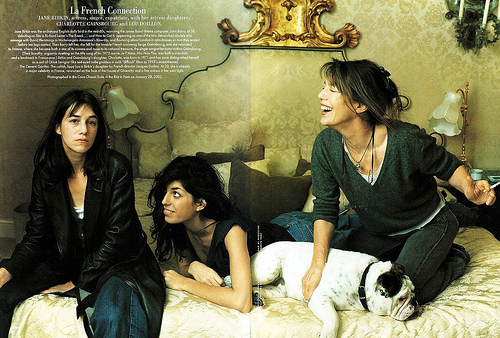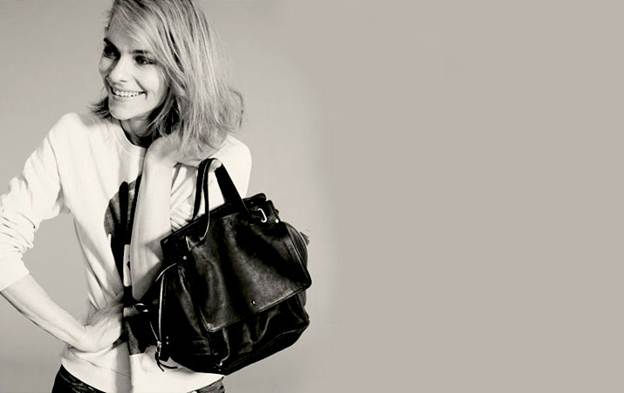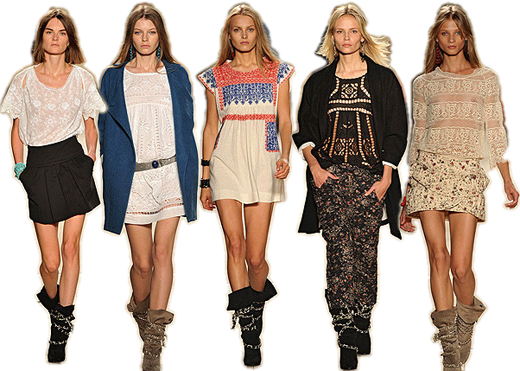Understated enough to look like you haven’t
tried, cool enough to count. It’s this approach that propelled Emmanuelle Alt
onto the radar, in her skinny black jeans, punch-black eyes and spike-heel
boots. Alt styled Marant’s shows until she took the job as editor of French Vouge
last year; Alt’s hustband, Franck Durand, has been Marant’s artistic director
since 2005. You’ll see something similar on all the French girls in the front
row at shows: Clémence Poésy, Charlotte Gainsbourg, Lou Doillon … they all wear
designer labels, but warp them with age-old sneakers or beaten-up jeans.

This is what I love about the one piece of
Isabel Marant I own – a slight-shouldered bouclé jacket in a granite grey. I
wear it most days, probably because it manges to be unpretentious yet French
(tough gig). It is Paris by design, Paris by attitude, Paris by default. Sexy
and dark, like chocolate.
Marant’s approach makes for an
infinitely
more interesting appraisal of French style than the drivel we hear about
how
French women don’t get fat, wear frilly knickers, smoke Gauloises,
ignore their
children, never match their bags and shoes, and don’t do jokes. There’s
more to
being a French woman than “two lipsticks and a lover” (UK writer Helena
Frith Powell’s take on the matter). Better, I think, is a description
from French
actress Sara Forestier: “French women are like magnets. Sometimes we
attract;
other times we repulse. We are alternately hot and cold. Distant and
passionate. It is to do with our origins, a mix of Latin and Celtic.”
Marant takes her eight year old son, Tal,
to schook each day, “dressed in a scruffy jacket, with the hood up” and cringes
as other mothers at the gates compare new Isabel Marant boots. “I hate it!” she
shudders, seemingly repelled by her own success.
Her desire for privacy explains why, each
weekend, Marant and her husband (accessories designer Jérôme Dreyfuss) take Tal
to a tiny hut on the Loing river in Fontainebleau, 70km from Paris. The fridge
is a vintage icebox by the riverbank; the toilet is flushed with a bucket. As
Dreyfuss has said, “It’s surprising how little you need.”

“She’s probably the least materialistic
person I’ve ever come across in fashion,” claims How. It may seem an odd
description of someone who produces $2000 leggings, but apparently her designs
are as much artistic pursuit as money-making enterprise.
“My clothes reflect who I am,” says Marant.
“When I start each collection, there’s a lot of introspection, philosophical
questions: ‘Why would I buy one thing more than another? What didn’t I do well
last time that I can achieve better now?’ It’s a gestation. “My aim in fashion
when I started was to open my wardrobe and ask, ‘What can I wear today?’ There
are a lot of garments that are very beautiful, but too beautiful to wear. Some
of my favourite clothes are the ones I’ve had for ages, rough maybe, but they
just feel right.”
Marant’s achievement has been to give busy,
middle-aged women a new uniform – sexy edgy, practical. No wonder it’s spawning
so many look-alikes. Almost everything I buy these days owes a debt to Marant.
“Becoming a global brand is hard for her,” admits How. “She has to perform.
[The label] is growing almost faster than she can cope with, despite having
fantastic staff. She’s stretched because she wants her hand on everything and
doesn’t want anything to slip through her fingers – actually she can’t leave it
alone, which is why it’s so successful. For Isabel, it’s all about the process.
Whereas most designers manufacture their collections in Italy, her clothes are mostly produced on-site.”
“I do all the prototypes here,” confirms
Marant as she leads me through the atelier. “I need to see the garment being
built up step by step. Sometimes from first drawing to final garment, it is
totally different. I’m bever happy. I’m never enthusiastic. But it’s what
drives me. A week before the last [spring/summer] show, I was already drawing
winter, precisely from the frustration I had with summer. I knew it wasn’t
right. And then I start to sketch again. I cannot allow myself to have no
ideas.”

No wonder she looks as exhausted as her
sneakers. Her relaxation (“I was a big party girl in the past,” she grins) is
to listen to indie rockers Arcade Fire on her headphones.
“I need that comedown. I have crazy days.
Everybody comes to me and I can’t leave the office without putting my music on,
going back into myself and saying, ‘OK, you had this in your soul and you’ve
seen this today, does it correspond?’ – because I must give answers, right
away, to everything.”